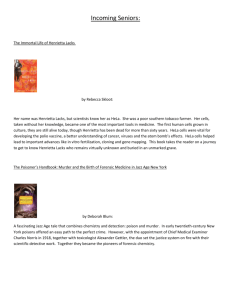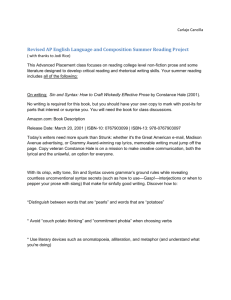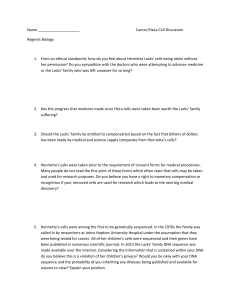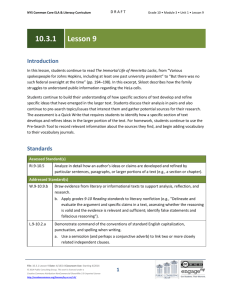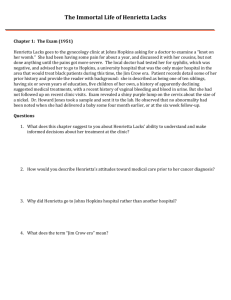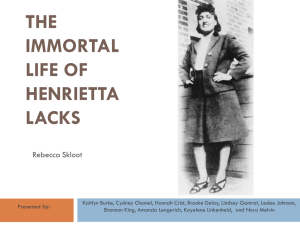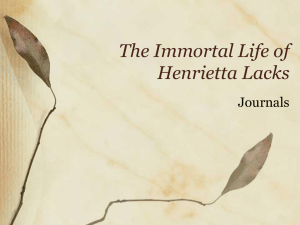Grade 10 ELA Module 3, Unit 1, Lesson 3
advertisement
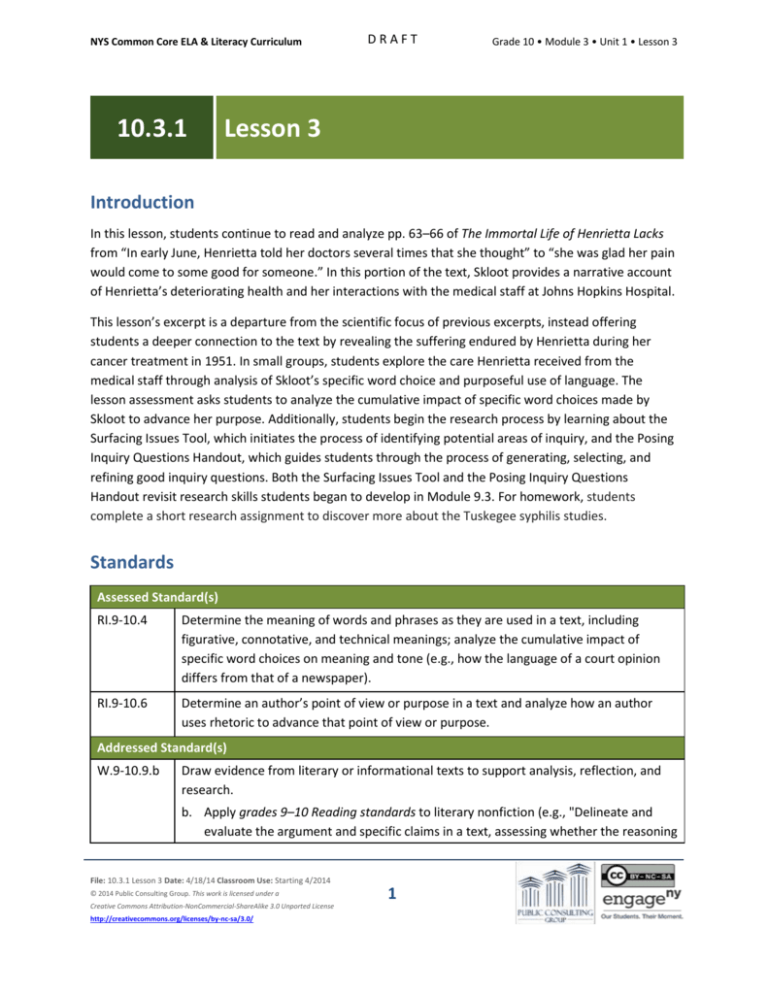
NYS Common Core ELA & Literacy Curriculum 10.3.1 DRAFT Grade 10 • Module 3 • Unit 1 • Lesson 3 Lesson 3 Introduction In this lesson, students continue to read and analyze pp. 63–66 of The Immortal Life of Henrietta Lacks from “In early June, Henrietta told her doctors several times that she thought” to “she was glad her pain would come to some good for someone.” In this portion of the text, Skloot provides a narrative account of Henrietta’s deteriorating health and her interactions with the medical staff at Johns Hopkins Hospital. This lesson’s excerpt is a departure from the scientific focus of previous excerpts, instead offering students a deeper connection to the text by revealing the suffering endured by Henrietta during her cancer treatment in 1951. In small groups, students explore the care Henrietta received from the medical staff through analysis of Skloot’s specific word choice and purposeful use of language. The lesson assessment asks students to analyze the cumulative impact of specific word choices made by Skloot to advance her purpose. Additionally, students begin the research process by learning about the Surfacing Issues Tool, which initiates the process of identifying potential areas of inquiry, and the Posing Inquiry Questions Handout, which guides students through the process of generating, selecting, and refining good inquiry questions. Both the Surfacing Issues Tool and the Posing Inquiry Questions Handout revisit research skills students began to develop in Module 9.3. For homework, students complete a short research assignment to discover more about the Tuskegee syphilis studies. Standards Assessed Standard(s) RI.9-10.4 Determine the meaning of words and phrases as they are used in a text, including figurative, connotative, and technical meanings; analyze the cumulative impact of specific word choices on meaning and tone (e.g., how the language of a court opinion differs from that of a newspaper). RI.9-10.6 Determine an author’s point of view or purpose in a text and analyze how an author uses rhetoric to advance that point of view or purpose. Addressed Standard(s) W.9-10.9.b Draw evidence from literary or informational texts to support analysis, reflection, and research. b. Apply grades 9–10 Reading standards to literary nonfiction (e.g., "Delineate and evaluate the argument and specific claims in a text, assessing whether the reasoning File: 10.3.1 Lesson 3 Date: 4/18/14 Classroom Use: Starting 4/2014 © 2014 Public Consulting Group. This work is licensed under a Creative Commons Attribution-NonCommercial-ShareAlike 3.0 Unported License http://creativecommons.org/licenses/by-nc-sa/3.0/ 1 NYS Common Core ELA & Literacy Curriculum DRAFT Grade 10 • Module 3 • Unit 1 • Lesson 3 is valid and the evidence is relevant and sufficient; identify false statements and fallacious reasoning") L.9-10.4.a Determine or clarify the meaning of unknown and multiple-meaning words and phrases based on grades 9–10 reading and content, choosing flexibly from a range of strategies. a. Use context (e.g., the overall meaning of a sentence, paragraph, or text; a word's position or function in a sentence) as a clue to the meaning of a word or phrase. Assessment Assessment(s) Student learning is assessed via a Quick Write at the end of the lesson. Students respond to the following prompt, citing textual evidence to support analysis and inferences drawn from the text. How does the cumulative impact of specific word choices and phrases advance Skloot’s purpose in this excerpt? Differentiation Consideration: If students struggle, consider providing specific phrases such as “miserable specimen” or “benevolent deception” to support their responses. High Performance Response(s) A High Performance Response should: Explain that Skloot’s purpose in the chapter is to depict the indifferent and detached treatment Henrietta receives from the medical community during the final stages of her illness. Cite specific word choices and/or phrases that advance Skloot’s purpose (e.g., Skloot cites phrases such as “miserable specimen,” used by doctors to describe Henrietta, and “benevolent deception,” to describe the concept of doctors withholding information from patients, along with “doctors knew best” to describe patients’ trust in their physicians. She further conveys the racial implications of the time with, “it was understood that black people didn’t question white people’s professional judgment.” Skloot also shares how Henrietta continued to go to doctors with “discomfort” and how they repeatedly sent her away citing “No evidence of recurrence” until the end of her illness when her need for medical care surpassed the ability to treat her). If students infer that Skloot’s purpose is to reveal the medical community’s bigoted treatment of Henrietta during her cancer treatment, they must provide sufficient textual evidence to support the inference. File: 10.3.1 Lesson 3 Date: 4/18/14 Classroom Use: Starting 4/2014 © 2014 Public Consulting Group. This work is licensed under a Creative Commons Attribution-NonCommercial-ShareAlike 3.0 Unported License http://creativecommons.org/licenses/by-nc-sa/3.0/ 2 NYS Common Core ELA & Literacy Curriculum DRAFT Grade 10 • Module 3 • Unit 1 • Lesson 3 Vocabulary Vocabulary to provide directly (will not include extended instruction) deception (n.) – the act of deceiving (misleading by false appearance or statement) specimen (n.) – a sample of a substance or material for examination or study Vocabulary to teach (may include direct word work and/or questions) benevolent (adj.) – characterized by expressing goodwill or kindly feelings; charitable vain (adj.) – ineffectual or unsuccessful; futile Lesson Agenda/Overview Student-Facing Agenda % of Lesson Standards & Text: Standards: RI.9-10.4, RI.9-10.6, W.9-10.9.b, L.9-10.4.a Text: The Immortal Life of Henrietta Lacks, pp. 63–66 Learning Sequence: 1. 2. 3. 4. 5. 6. 7. Introduction of Lesson Agenda Homework Accountability Masterful Reading Reading and Discussion Quick Write Surfacing Issues and Posing Inquiry Questions Closing 1. 2. 3. 4. 5. 6. 7. Materials Student copies of the 10.3.1 Unit Glossary (refer to 10.3.1 Lesson 1) Student copies of the Short Response Rubric and Checklist (refer to 10.3.1 Lesson 1) Copies of the Surfacing Issues Tool for each student Copies of the Posing Inquiry Questions Handout for each student File: 10.3.1 Lesson 3 Date: 4/18/14 Classroom Use: Starting 4/2014 © 2014 Public Consulting Group. This work is licensed under a Creative Commons Attribution-NonCommercial-ShareAlike 3.0 Unported License http://creativecommons.org/licenses/by-nc-sa/3.0/ 3 5% 10% 15% 35% 10% 20% 5% NYS Common Core ELA & Literacy Curriculum DRAFT Grade 10 • Module 3 • Unit 1 • Lesson 3 Learning Sequence How to Use the Learning Sequence Symbol Type of Text & Interpretation of the Symbol 10% Percentage indicates the percentage of lesson time each activity should take. Plain text indicates teacher action. Bold text indicates questions for the teacher to ask students. Italicized text indicates a vocabulary word. Indicates student action(s). Indicates possible student response(s) to teacher questions. Indicates instructional notes for the teacher. no symbol Activity 1: Introduction of Lesson Agenda 5% Begin by reviewing the agenda and assessed standards for this lesson: RI.9-10.4 and RI.9-10.6. In this lesson, students read The Immortal Life of Henrietta Lacks, (pp. 63–66) and analyze the cumulative impact of specific word choices the author makes in advancing her purpose. Students then apply their analysis of this reading and previously analyzed excerpts to begin surfacing potential research issues while also posing inquiry questions about those potential research issues. Students look at the agenda. Activity 2: Homework Accountability 10% Instruct students to take out their written responses to the previous lesson’s homework prompt and Turn-and-Talk with a classmate about two ways in which the events and ideas work together to shape the culminating event. Student responses may include: o o o The Pap smear informed and furthered TeLinde’s research. TeLinde partnered with George Gey to research cell tissue at the same time Henrietta went to Johns Hopkins for treatment. TeLinde scraped Henrietta’s cell tissue because he collected “samples from any woman who happened to walk into Hopkins with cervical cancer. Including Henrietta” (p. 30). Activity 3: Masterful Reading 15% Have students listen to a Masterful Reading of The Immortal Life of Henrietta Lacks, pp. 63–66. File: 10.3.1 Lesson 3 Date: 4/18/14 Classroom Use: Starting 4/2014 © 2014 Public Consulting Group. This work is licensed under a Creative Commons Attribution-NonCommercial-ShareAlike 3.0 Unported License http://creativecommons.org/licenses/by-nc-sa/3.0/ 4 NYS Common Core ELA & Literacy Curriculum DRAFT Grade 10 • Module 3 • Unit 1 • Lesson 3 Students follow along, reading silently. In the first paragraph on page 65 “Sadie, Margaret, and Day” are mentioned. Sadie and Margaret are Henrietta’s cousins. Day is short for David, Henrietta’s husband. Activity 4: Reading and Discussion 35% Instruct students to form small groups of 3–4. Post or project each set of questions below for students to discuss. Instruct student groups to reread pages 63–64 from “In early June, Henrietta told her doctors several times” to “She is obviously in pain. He sent her home to bed” and answer the following questions before sharing out with the class: Remind students to take notes or annotate the text as they engage in the evidence-based discussion that follows. This annotation supports students’ engagement with W.9-10.9.b, which addresses the use of textual evidence in writing. Instruct students to consult the 10.3.1 Unit Glossary for the terms found in today’s reading, including deception and specimen. Instruct students to underline each time Skloot references a statement from the medical profession about Henrietta’s condition and circle Henrietta’s responses or feelings about her health. Student responses should include: Underlined: o “but they found nothing wrong with her” (p. 63) o “No evidence of recurrence. Return in one month.” (p. 63) o “The patient states that she feels fairly well . . . however she continues to complain of some vague lower abdominal discomfort” (p. 63) o “the doctor told her she was fine” (p. 64) o “No evidence of recurrence. Return in one month.” (p. 64) o “The patient looks chronically ill. She is obviously in pain.” (p. 64) Circled: o “She thought the cancer was spreading, that she could feel it moving through her” (p. 63) o “however she continues to complain of some vague lower abdominal discomfort” (p. 63) o “she went back to Hopkins saying that the ‘discomfort’ she’d complained about” (p. 64) o “The pain made it hard to walk. She went back to Hopkins.” (p. 64) o “Three days later, when she returned complaining once again of pain” (p. 64) File: 10.3.1 Lesson 3 Date: 4/18/14 Classroom Use: Starting 4/2014 © 2014 Public Consulting Group. This work is licensed under a Creative Commons Attribution-NonCommercial-ShareAlike 3.0 Unported License http://creativecommons.org/licenses/by-nc-sa/3.0/ 5 NYS Common Core ELA & Literacy Curriculum DRAFT Grade 10 • Module 3 • Unit 1 • Lesson 3 Why does Skloot include repeated references to both Henrietta’s health and the doctor’s responses? Skloot shows that despite the symptoms Henrietta was experiencing, she was not questioning her doctors; the prevailing opinion of the time was “Doctors knew best and most patients didn’t question that” (p. 63). Henrietta’s concerns were not taken seriously until, after repeated visits to Johns Hopkins for help, one doctor found “a ‘stony hard’ mass” (p. 64) when he pressed on her abdomen. Skloot writes, “Only weeks after a previous entry had declared her healthy, one of the doctors wrote, ‘The patient looks chronically ill’” (p. 64). Based on Skloot’s explanation of “benevolent deception” on page 63, what is meant by the word benevolent in this context? Skloot explains the term “benevolent deception” as a “common practice” whereby “doctors often withheld even the most fundamental information from their patients, sometimes not giving them any diagnosis at all. They believed it was best not to confuse or upset patients with frightening terms they might not understand, like cancer” (p. 63). Based on this explanation, benevolent means to do something with the intent to be nice or charitable. It may be necessary to provide students with the definition of deception for this discussion. Consider drawing students’ attention to their application of standard L.9-10.4.a through the process of using context to make meaning of a word. How does Skloot’s description of the time period further develop the idea that Henrietta might have “deferred to anything her doctors said” (p. 63)? Skloot explains, “This was 1951 in Baltimore, segregation was law, and it was understood that black people didn’t question white people’s professional judgment” (p. 63). Skloot explains, “Many black patients were just glad to be getting treatment” (p. 63–64). Why might Skloot have included this historical description when explaining Henrietta’s declining health? Skloot wants to show that race may have played a role in Henrietta’s doctors not heeding her health warnings early on. Even though Skloot says “All we can know for sure are the facts of Henrietta’s medical records” (p. 64), she continues to point out Henrietta’s repeated attempts to communicate her “discomfort” (pp. 63–64) with the doctors continuing to note “No evidence of recurrence”(pp. 63–64). Lead a brief whole-class discussion of student responses. File: 10.3.1 Lesson 3 Date: 4/18/14 Classroom Use: Starting 4/2014 © 2014 Public Consulting Group. This work is licensed under a Creative Commons Attribution-NonCommercial-ShareAlike 3.0 Unported License http://creativecommons.org/licenses/by-nc-sa/3.0/ 6 NYS Common Core ELA & Literacy Curriculum DRAFT Grade 10 • Module 3 • Unit 1 • Lesson 3 Instruct student groups to reread all of page 65, from “Until that point, no one except Sadie, Margaret, and Day” to “her cells died immediately in culture” and answer the following questions before sharing out with the class. How does Skloot distinguish what the doctors knew and what they told the Lacks family? The Lacks family “didn’t realize she was dying. They thought the doctors were still trying to cure her” (p. 65) while at the same time doctors were just trying to “ease the pain until her death” (p. 65) with increasing amounts of radiation. What words or phrases does Skloot use to communicate Henrietta’s decline in health? Student responses may include: o o o o o “They could hear Henrietta from a block away, wailing for the Lord to help her” (p. 65) “stone-hard tumors filled the inside of her abdomen” (p. 65) “In view of the rapid extension of the disease process the outlook is quite poor” (p. 65) “Henrietta couldn’t walk from the house to the car” (p. 65) “Patient has been complaining bitterly of pain and she seems genuinely miserable” (p. 65) How does the description of Henrietta’s treatment on page 66, help you understand the meaning of the word vain in this context? Skloot says “Her doctors tried in vain to ease her suffering” (p. 66) and goes on to describe all of the medicines doctors gave Henrietta to help relieve her pain that did not help her, so vain in this context means that their efforts did not work. What phrase did doctors use to describe Henrietta on page 66? Doctors call her a “miserable specimen.” The word specimen can be defined as “a sample of a substance or material for examination or study.” Why might the doctor use that word to refer to a patient? The doctor did not relate to Henrietta as a person but as something to be studied. What is the impact of the word specimen in describing Henrietta? It creates a sense of distance or detachment on behalf of the medical staff who try to help her and see their efforts fail. Skloot shares that someone wrote in Henrietta’s chart: “As far as I can see we are doing all that can be done” (p. 66). Lead a brief whole-class discussion of student responses. File: 10.3.1 Lesson 3 Date: 4/18/14 Classroom Use: Starting 4/2014 © 2014 Public Consulting Group. This work is licensed under a Creative Commons Attribution-NonCommercial-ShareAlike 3.0 Unported License http://creativecommons.org/licenses/by-nc-sa/3.0/ 7 NYS Common Core ELA & Literacy Curriculum DRAFT Grade 10 • Module 3 • Unit 1 • Lesson 3 Activity 5: Quick Write 10% Instruct students to respond briefly in writing to the following prompt: How does the cumulative impact of specific word choices and phrases advance Skloot’s purpose in this excerpt? Instruct students to look at their annotations to find evidence. Ask students to use this lesson’s vocabulary wherever possible in their written responses. Remind students to use the Short Response Rubric and Checklist to guide their written responses. Display the prompt for students to see, or provide the prompt in hard copy. Students independently answer the prompt, using evidence from the text. See the High Performance Response at the beginning of this lesson. Activity 6: Surfacing Issues and Posing Inquiry Questions 20% Share with students that they have been reading and analyzing texts (in this and previous modules) for several purposes, including developing skills in evidence-based discussion and writing. Explain that this type of reading and writing also fosters skills necessary to build evidence-based arguments around a problem-based question for research. For the purposes of this and subsequent lessons, the text analysis is about analyzing the text itself, based on the standards, and about surfacing topics that are potentially interesting and rich to research. These initial topics begin the inquiry process. As the process unfolds, aspects of the topics develop as questions are posed and refined and pre-research is conducted. Students listen. Explain to students that as they initiate the process of inquiry and research, they begin to contemplate issues surfaced in The Immortal Life of Henrietta Lacks. The term issue can be defined as: An important aspect of human society for which there are many different opinions about what to think or do. Many issues can be framed as a problem-based question. Distribute the Surfacing Issues Tool to students and ask them to brainstorm 3–4 issues that have surfaced in their initial reading of the excerpts from The Immortal Life of Henrietta Lacks. Students record issues in the left column on the Surfacing Issues Tool. Student responses may include the following: o o o Human tissue research Racial issues in medical care Consent for tissues to be used in medical research File: 10.3.1 Lesson 3 Date: 4/18/14 Classroom Use: Starting 4/2014 © 2014 Public Consulting Group. This work is licensed under a Creative Commons Attribution-NonCommercial-ShareAlike 3.0 Unported License http://creativecommons.org/licenses/by-nc-sa/3.0/ 8 NYS Common Core ELA & Literacy Curriculum o DRAFT Grade 10 • Module 3 • Unit 1 • Lesson 3 The evolution of cancer treatment Lead a brief class share-out about issues surfaced. Students should record the page number location of the issue in the text and a description of key information related to the issue. Students share issues surfaced and record the page number and description of key information related to the issue on the Surfacing Issues Tool. Instruct students to keep out their Surfacing Issues Tool. Inform students they will continue to record topics in this way in future lessons, and that today they begin to use these topics to generate inquiry questions as they begin the process of building evidence-based arguments around research. Explain that during this research process, they use inquiry questions to guide their research and analysis. This process is recurring and students continue to surface new questions as they acquire information about their research topics. Students listen. Inform students that The Immortal Life of Henrietta Lacks is used to generate sample topics/issues for research in this module. Explain that Skloot touches on many topics/issues throughout the first excerpts of The Immortal Life of Henrietta Lacks. Of these, they use human tissue research as a sample topic/issue to generate inquiry questions as a class. Students listen. All research topics should be issues that garner multiple perspectives and claims. Distribute the Posing Inquiry Questions Handout to students. Inform them that they are to focus on generating inquiry questions that they select and refine in later lessons. At this stage, the inquiry questions are meant to guide an initial exploration of a topic or issue that is surfaced from the text. Instruct students to read the Generating Questions portion of the handout. Students read the Generating Questions portion of the handout. Explain to students that by using the questions on the handout concerning each individual topic, it is possible to come up with a wide variety of inquiry questions. Remind students to consider what they find interesting and what they would like to know more about when they are generating questions. Explain to students at this stage it is best to brainstorm as many questions as possible. Students listen. Display the human tissue research topic for students and the example inquiry question: How is human tissue research beneficial in disease prevention? Explain to students that based on the “What other topics/issues is it connected to or associated with?” prompt from the handout, this is an open-ended inquiry question. Ask students to volunteer potential inquiry questions for the issue of human tissue research. File: 10.3.1 Lesson 3 Date: 4/18/14 Classroom Use: Starting 4/2014 © 2014 Public Consulting Group. This work is licensed under a Creative Commons Attribution-NonCommercial-ShareAlike 3.0 Unported License http://creativecommons.org/licenses/by-nc-sa/3.0/ 9 NYS Common Core ELA & Literacy Curriculum DRAFT Grade 10 • Module 3 • Unit 1 • Lesson 3 Student responses may include: o o o o o o o What is defined as human tissue? Where did human tissue research originate? What is the history of human tissue research? What are the major aspects of human tissue research? Who are experts in human tissue research? Who is affected by human tissue research? Who profits from human tissue research? Instruct students to form pairs, choose a topic from the Surfacing Issues Tool, and generate five inquiry questions for that topic/issue. Student responses vary depending on the potential research topic/issue but may include: o o o o o o o Topic: Race issues in medical care Inquiry Questions: What is the history of racial issues in medical care? Who has been most affected by racial issues in medical care? What are major aspects of race in medical care? What are important advances in racial issues concerning medical care? In what way do racial issues in medical care reflect racial issues in society? Activity 7: Closing 5% Display and distribute the homework assignment. For homework, instruct students to conduct a web search, finding resources about the history of the Tuskegee syphilis studies. Instruct students to come to class prepared to discuss the nature of this study as well as the resources that assisted with comprehension and understanding. These resources should include common online reference materials and other online resources such as audio and video. Students follow along. Homework Conduct a web search to discover more about the Tuskegee syphilis studies conducted at the Tuskegee Institute. Summarize the study in your own words. How do the resources you found help you understand this study? Be prepared to discuss the nature of this study as well as the resources you found. These resources should include common online reference materials and other online resources such as audio and video. File: 10.3.1 Lesson 3 Date: 4/18/14 Classroom Use: Starting 4/2014 © 2014 Public Consulting Group. This work is licensed under a Creative Commons Attribution-NonCommercial-ShareAlike 3.0 Unported License http://creativecommons.org/licenses/by-nc-sa/3.0/ 10 DRAFT NYS Common Core ELA & Literacy Curriculum Grade 10 • Module 3 • Unit 1 • Lesson 3 Surfacing Issues Tool Name: Issue Class: Date: Page Number(s) Key Information about the Issue from the Text From Odell Education Researching to Deepen Understanding Framework, by Odell Education, www.odelleducation.com. Copyright (2013) by Odell Education. Adapted with permission under an Attribution-NonCommercial 3.0 Unported license: http://creativecommons.org/licenses/by-nc/3.0/. File: 10.3.1 Lesson 3 Date: 4/18/14 Classroom Use: Starting 4/2014 © 2014 Public Consulting Group. This work is licensed under a Creative Commons Attribution-NonCommercial-ShareAlike 3.0 Unported License http://creativecommons.org/licenses/by-nc-sa/3.0/ 11 DRAFT NYS Common Core ELA & Literacy Curriculum Grade 10 • Module 3 • Unit 1 • Lesson 3 Model Surfacing Issues Tool Name: Class: Date: Issue Page Number(s) Key Information about the Issue from the Text Human tissue research 2, 4, 30 Henrietta’s cells are the first immortal human cells and have been used for a wide variety of medical and scientific purposes (pp. 2, 4). George Gey works to develop the first line of immortal human cells (p. 30). Race issues in medical care 30, 63–64 Scientists often used black patients from Johns Hopkins for research in lieu of receiving payment for medical services, usually without their knowledge (p. 30). Black patients in public wards did not question white people’s professional judgment, but there is no way of knowing if Henrietta’s treatment would have been different if she had been white (pp. 63–64). Consent for tissues to be used in medical research 29, 31, 33 Patients from public wards were often used for research without their knowledge (p. 29). Henrietta signed a consent form for operative procedures, but not for the donation of her tissue for research (pp. 31, 33). The evolution of cancer treatment 27–30, 32–33 TeLinde wanted to prove that carcinoma in situ could become invasive cervical cancer so that the non-invasive cancers could be treated more aggressively (pp. 27–30). Cancer in the mid-twentieth century was treated with radium (pp. 32–33). From Odell Education Researching to Deepen Understanding Framework, by Odell Education, www.odelleducation.com. Copyright (2013) by Odell Education. Adapted with permission under an Attribution-NonCommercial 3.0 Unported license: http://creativecommons.org/licenses/by-nc/3.0/. File: 10.3.1 Lesson 3 Date: 4/18/14 Classroom Use: Starting 4/2014 © 2014 Public Consulting Group. This work is licensed under a Creative Commons Attribution-NonCommercial-ShareAlike 3.0 Unported License http://creativecommons.org/licenses/by-nc-sa/3.0/ 12 DRAFT NYS Common Core ELA & Literacy Curriculum Grade 10 • Module 3 • Unit 1 • Lesson 3 Posing Inquiry Questions Handout Name: Class: Date: Generating Questions In this module, The Immortal Life of Henrietta Lacks is a starter or “seed text” that helps generate potential topics and issues that drive the research process. Issues and topics that are surfaced in the text will be used to pose inquiry questions. These inquiry questions will help illuminate different potential areas of investigation within a research topic. When generating inquiry questions, it is often a good idea to brainstorm as many as possible before selecting and refining the richest ones. Here are several to help you get started: How is the topic defined? What are its major aspects? Where did it originate? What are its causes and implications? What is its history? What other topics/issues is it connected to or associated with? What are its important places, things, people, and experts? Selecting and Refining Questions Once the brainstorming process is completed, it is important to review and select the strongest questions generated. Use these questions to assist with selecting and refining the strongest inquiry questions: Are you genuinely interested in answering your question? There is a lot of work involved in research, and genuine interest motivates the research process. The best questions are about things that are interesting to individual researchers and what they consider to be valuable information. Can your question truly be answered through your research? Some questions are unanswerable (Are there aliens on Jupiter?) or take years to answer (What are the long-term effects of sleep loss on a person’s health?). A suitable inquiry question is realistic and researchable within the timeframe available. File: 10.3.1 Lesson 3 Date: 4/18/14 Classroom Use: Starting 4/2014 © 2014 Public Consulting Group. This work is licensed under a Creative Commons Attribution-NonCommercial-ShareAlike 3.0 Unported License http://creativecommons.org/licenses/by-nc-sa/3.0/ 13 NYS Common Core ELA & Literacy Curriculum DRAFT Grade 10 • Module 3 • Unit 1 • Lesson 3 Is your question clear? Can you pose your question in a way that you and others understand what you are asking? Effective inquiry questions are straightforward and not confusing. If the question has two parts, it may be better to separate the parts to form two new questions. What sort of answers does your question require? Questions that can be answered with a simple “yes” or “no” generally do not make good inquiry questions. An inquiry question should support plenty of investigation that may even lead to multiple answers, and more questions. For example, the question “What are the characteristics of a cancer cell?” could lead to asking questions about how these characteristics are defined and when they were first discovered. Do you already know what the answer is? Suitable inquiry questions are actually questions that cannot be answered immediately. The research process involves inquiry, finding more information about a question, and developing a perspective based on the evidence discovered and this cannot happen if the question is already answered or too simplistic. For example, there is a big difference between the questions “How many types of cancer are there?” (an easily answered question that requires little research) and “What is the history of cancer research?” (a question that would require a lot of research). From Posing Inquiry Questions Handout, by Odell Education, www.odelleducation.com. Copyright (20132) by Odell Education. Modified in partnership with permission under an Attribution-NonCommercial 3.0 Unported license: http://creativecommons.org/licenses/by-nc/3.0/. File: 10.3.1 Lesson 3 Date: 4/18/14 Classroom Use: Starting 4/2014 © 2014 Public Consulting Group. This work is licensed under a Creative Commons Attribution-NonCommercial-ShareAlike 3.0 Unported License http://creativecommons.org/licenses/by-nc-sa/3.0/ 14
